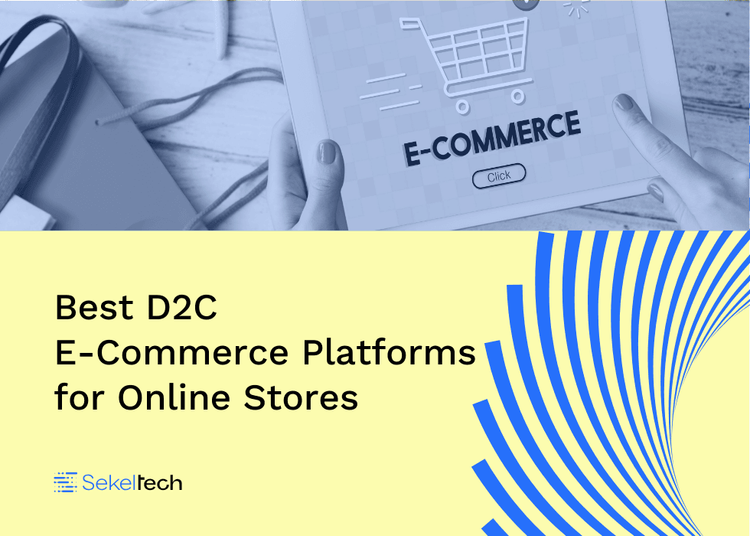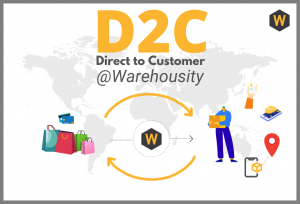Exploring the Prospective of D2C Ecommerce: A Comprehensive Guide for Organizations
The D2C ecommerce version provides a significant shift in how brand names engage with customers. It enables business to bypass typical retail channels, promoting much deeper links and possibly increased earnings margins. This technique is not without its intricacies. Recognizing the nuances of D2C ecommerce is vital for brands intending to thrive. What approaches can they adopt to navigate this evolving landscape successfully? The responses might redefine their business strategies.
Comprehending the D2C Ecommerce Model

Secret Benefits of D2C Ecommerce for Brands
The D2C ecommerce version offers brands substantial benefits, particularly concerning boosted earnings margins. By getting rid of intermediaries, companies can retain a bigger share of sales revenue. Additionally, this direct connection with customers cultivates improved brand commitment, motivating repeat acquisitions and long-term interaction.
Enhanced Revenue Margins

Boosted Brand Commitment
Building on the economic advantages of D2C ecommerce, boosted brand loyalty emerges as one more necessary benefit for business engaging directly with consumers. By developing a straight link, brand names can promote much deeper partnerships with their customers, acquiring understandings into behaviors and preferences. This straight communication enables even more personalized advertising and marketing techniques, which reverberate highly with customers. In addition, brands have the chance to regulate their messaging and consumer experience, reinforcing brand name values and developing depend on. When clients really feel an individual link, they are most likely to return, advocate for the brand name, and join neighborhood interaction. Eventually, enhanced brand commitment not just drives repeat purchases yet likewise cultivates a passionate client base, further solidifying a brand's placement in the marketplace.
Difficulties Dealt With by D2C Brands
D2C brands run into a number of substantial difficulties that can influence their success. Inventory monitoring concerns can cause stock scarcities or excess, complicating operations and customer fulfillment. In addition, advertising budget plan restraints often restrict the ability to properly get to and engage target audiences.
Stock Management Issues
Effective supply management offers a formidable obstacle for many brands running in the direct-to-consumer (D2C) space. These brand names typically grapple with rising and fall demand, which can lead to overstock or stockouts, inevitably impacting customer contentment and profits. Additionally, the lack of innovative supply radar can cause inconsistencies between real stock levels and reported data, complicating order gratification. The varied range of items D2C brand names usually supply additionally makes complex inventory administration, as variants in designs, colors, and dimensions require more careful oversight. Lots of D2C companies may battle with minimal warehousing capabilities, leading to ineffective usage of space and resources. Efficient inventory administration continues to be a critical hurdle for D2C brands intending for lasting development and operational effectiveness.
Marketing Budget Plan Constraints
Steering advertising spending plan restrictions is a substantial obstacle for lots of direct-to-consumer (D2C) brands. Restricted funds commonly limit these companies' ability to spend in all-encompassing advertising and marketing strategies, leading to reduced exposure in an affordable market. D2C brands frequently grapple with the demand to take full advantage of return on financial investment (ROI) while targeting details target markets properly. This difficulty is aggravated by climbing expenses in digital advertising and marketing and the need to assign funds throughout numerous channels, consisting of social media sites, search engines, and email marketing. Consequently, many D2C brand names need to innovate economical advertising and marketing remedies, leveraging natural growth techniques and influencer partnerships. Ultimately, effectively steering these budget restrictions is vital for maintaining development and accomplishing lasting profitability in the evolving ecommerce landscape.
Strategies for Building a Successful D2C Ecommerce Service
As customers significantly look for direct connections with brands, developing a successful D2C ecommerce business calls for a strategic strategy that focuses on customer engagement and depend on. One efficient strategy is to create compelling brand name stories that reverberate with target market, fostering psychological links. Making use of social networks platforms can improve presence and facilitate two-way communication, allowing brand names to involve straight with customers.Moreover, personalized experiences through tailored marketing efforts can significantly enhance customer retention and commitment. Carrying out commitment programs and offering special bargains can additionally incentivize repeat purchases.Streamlining the buying process is necessary, ensuring an easy to use user interface that improves the buying experience. Furthermore, transparent communication regarding delivery and returns constructs trust fund and encourages consumer confidence.Finally, proactively looking for customer feedback and replying to it demonstrates a commitment to improvement and customer fulfillment, critical elements in the competitive D2C landscape.
Leveraging Modern Technology for Boosted Client Experience
In today's affordable D2C ecommerce landscape, innovation plays a critical role fit client experiences. Companies significantly utilize advanced devices such as man-made intelligence, chatbots, and customized algorithms to enhance interactions and improve the shopping process. By integrating these modern technologies, brands can offer tailored item suggestions based on private preferences and purchasing habits, cultivating a much more appealing experience.Moreover, responsive internet site styles and mobile applications guarantee that clients can access solutions perfectly throughout various gadgets. Improved repayment remedies, including digital budgets and one-click check outs, better streamline transactions, making it easier for customers to make purchases.Data analytics likewise makes it possible for companies to collect insights right into customer habits, permitting for continual renovation of offerings and services. Overall, leveraging technology not just improves consumer satisfaction yet likewise cultivates loyalty, inevitably driving lasting success in the D2C ecommerce sector.
Advertising Tips to Drive D2C Sales
Just how can brands effectively catch the attention of customers in a saturated market? To prosper in the direct-to-consumer (D2C) landscape, read more brands have to use targeted advertising and marketing tactics. Using social media sites platforms, brands can involve customers via interactive material, influencer partnerships, and user-generated messages. Customized e-mail campaigns can additionally foster a feeling of connection, offering customized promotions based on customer behavior and preferences.Moreover, storytelling plays an essential duty in setting apart a brand's narrative, making it relatable and remarkable. Brand names must purchase seo (SEO) to enhance presence, ensuring their items are conveniently discoverable online. Furthermore, leveraging data analytics enables companies to fine-tune their marketing techniques and comprehend customer patterns much better. Ultimately, a multi-channel approach that incorporates imagination with data-driven understandings can significantly enhance D2C sales, allowing brands to stick out in a jampacked marketplace.
Future Fads in D2C Ecommerce
With the quick development of modern technology and customer choices, the future of D2C ecommerce is poised for significant transformation. Emerging fads suggest a shift towards hyper-personalization, where brands leverage information analytics to customize offerings to private consumer demands. This modification improves client experiences, promoting commitment and engagement.Moreover, sustainability is ending up being a vital variable, with consumers increasingly favoring brand names that prioritize environment-friendly methods - D2C Ecommerce Agency. Business are anticipated to embrace transparent supply chains and sustainable products to satisfy this demand.The integration of man-made intelligence and boosted fact will additionally transform the shopping experience, enabling consumers to picture products in their settings before purchase. In addition, social business is prepared for to grow, as systems like Instagram and TikTok assist in smooth purchasing experiences straight within social media.These trends jointly represent a dynamic future for D2C ecommerce, emphasizing customer-centric approaches and ingenious modern technologies that redefine customer communications
Frequently Asked Concerns
What Industries Advantage The Majority Of From D2C Ecommerce?
The existing question highlights sectors that thrive via direct-to-consumer (D2C) ecommerce. Incredibly, style, elegance, electronics, and food markets leverage D2C versions to increase brand commitment, improve client connections, and optimize earnings margins efficiently.
Exactly How Do Shipping Expenses Impact D2C Pricing Methods?
Delivering expenses significantly influence D2C pricing techniques. Organizations must balance these expenditures with competitive prices, taking into consideration customer assumptions and earnings margins. Efficient administration of shipping can improve customer complete satisfaction and drive sales in direct-to-consumer models.
What Payment Options Should D2C Businesses Offer?
D2C organizations must use varied repayment alternatives, including credit/debit cards, electronic wallets, and get now, pay later services. This range improves consumer comfort, raises conversion prices, and caters to various consumer choices in the online shopping landscape.
Exactly How Can D2C Brands Manage Client Returns Successfully?
D2C brand names can manage customer returns effectively by carrying out user-friendly return plans, offering pre paid delivery labels, and guaranteeing prompt refunds (D2C Ecommerce Agency). Clear interaction and structured procedures boost consumer satisfaction and motivate repeat business
What Lawful Considerations Exist for D2C Ecommerce Operations?
Lawful factors to consider for D2C ecommerce procedures include compliance with consumer defense regulations, information privacy laws, copyright rights, and taxation requirements. Brands should browse these complexities to stay clear of legal mistakes and guarantee smooth operations. By getting rid of middlemans, D2C brand names can supply competitive rates and promote an extra intimate relationship with their customers.The D2C model is defined by its dependence on electronic platforms, enabling brand names to utilize social media, online markets, and their very own internet sites to involve with consumers straight. D2C ecommerce promotes the collection of useful customer data, enabling brand names to customize their offerings and advertising and marketing techniques successfully, ultimately driving sales and raising margins. Furthermore, brands have the chance to regulate their messaging and consumer experience, enhancing brand values and building depend on. As consumers increasingly look for direct links with brands, establishing a successful D2C ecommerce organization needs a calculated method that prioritizes client involvement and trust. D2C brands can manage customer returns efficiently by applying user-friendly return policies, supplying pre paid delivery tags, and guaranteeing prompt refunds.
Comments on “How a D2C Ecommerce Agency Elevates the Mobile Shopping Experience”